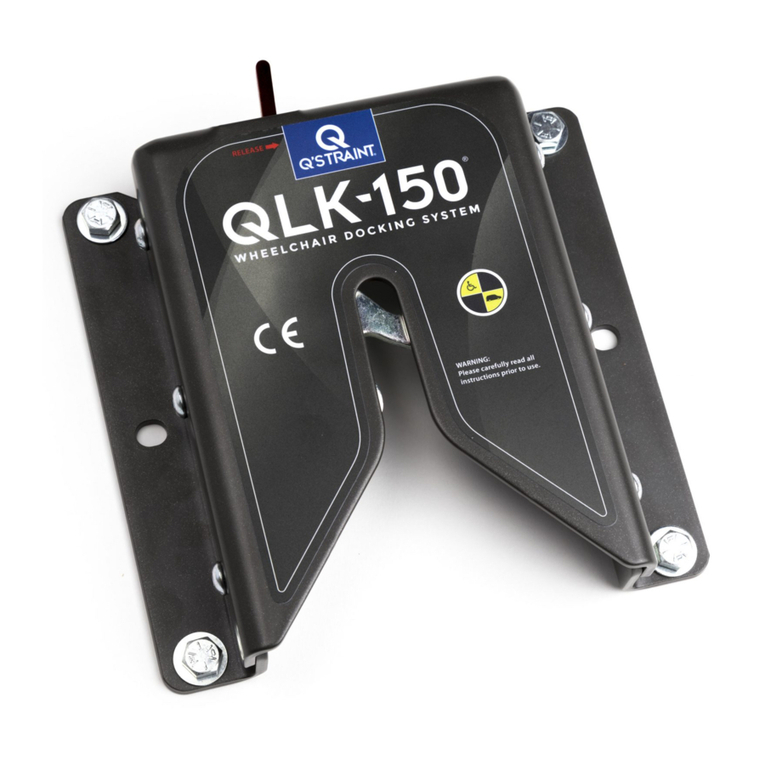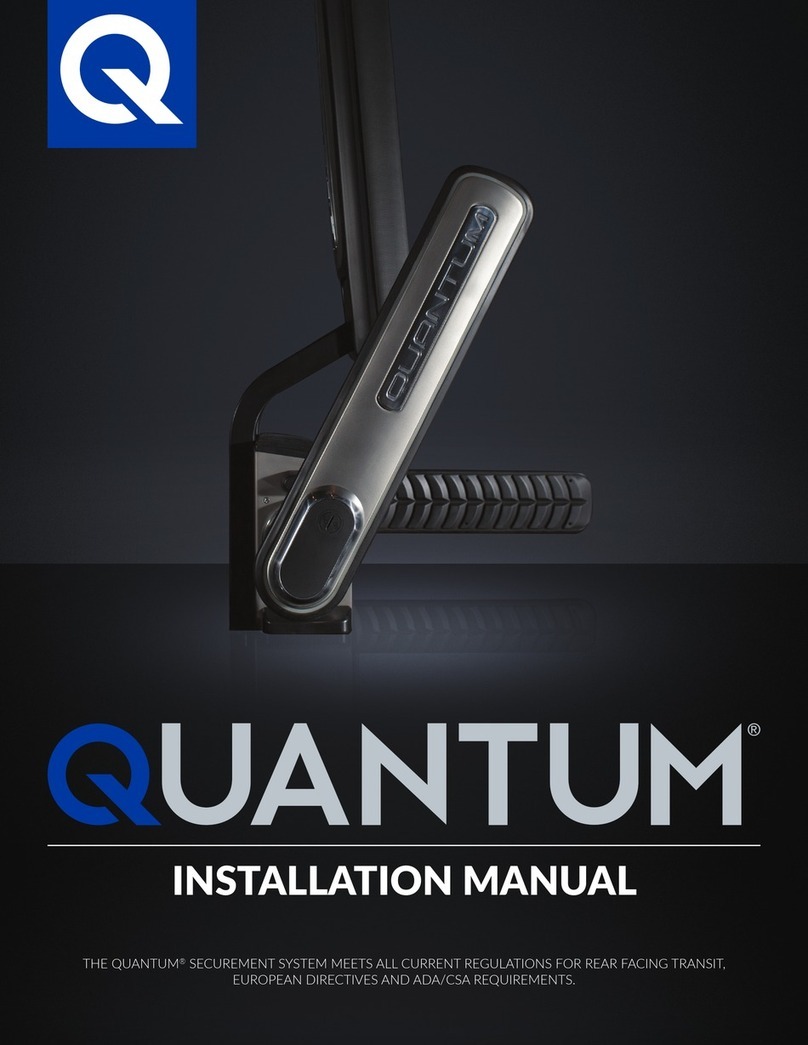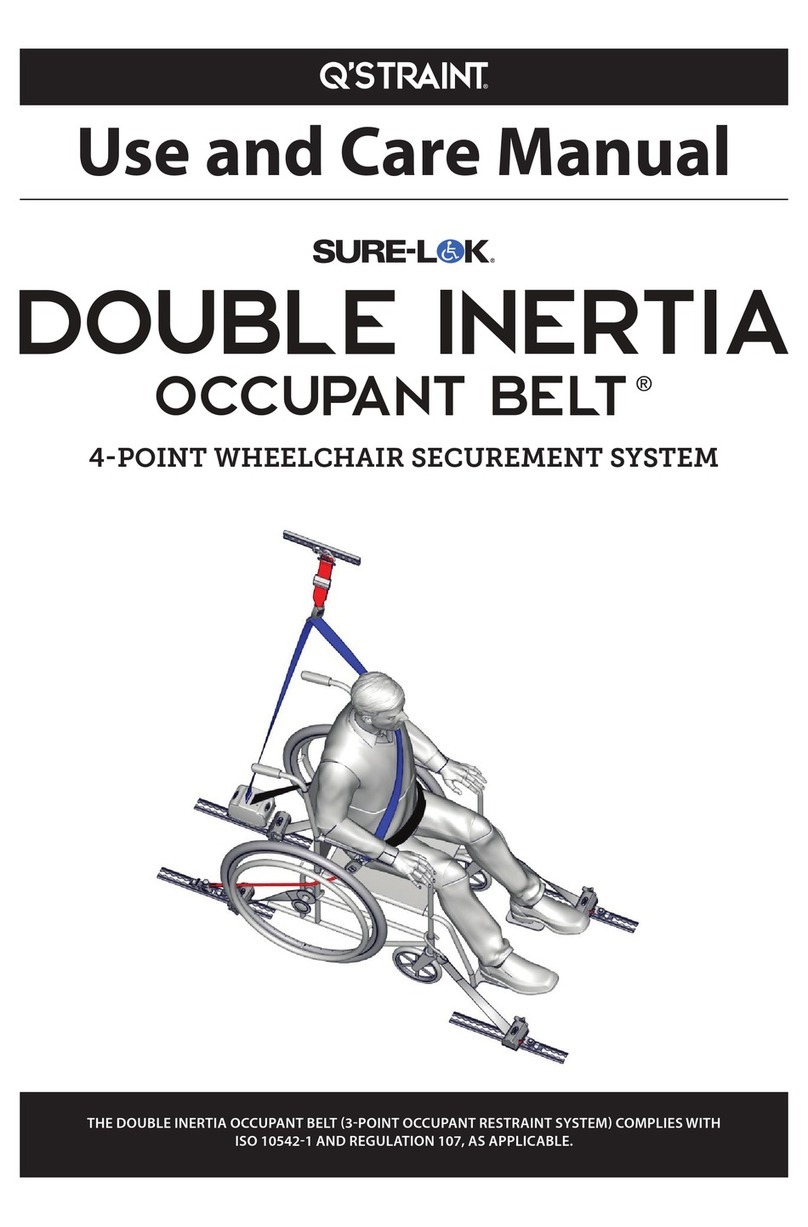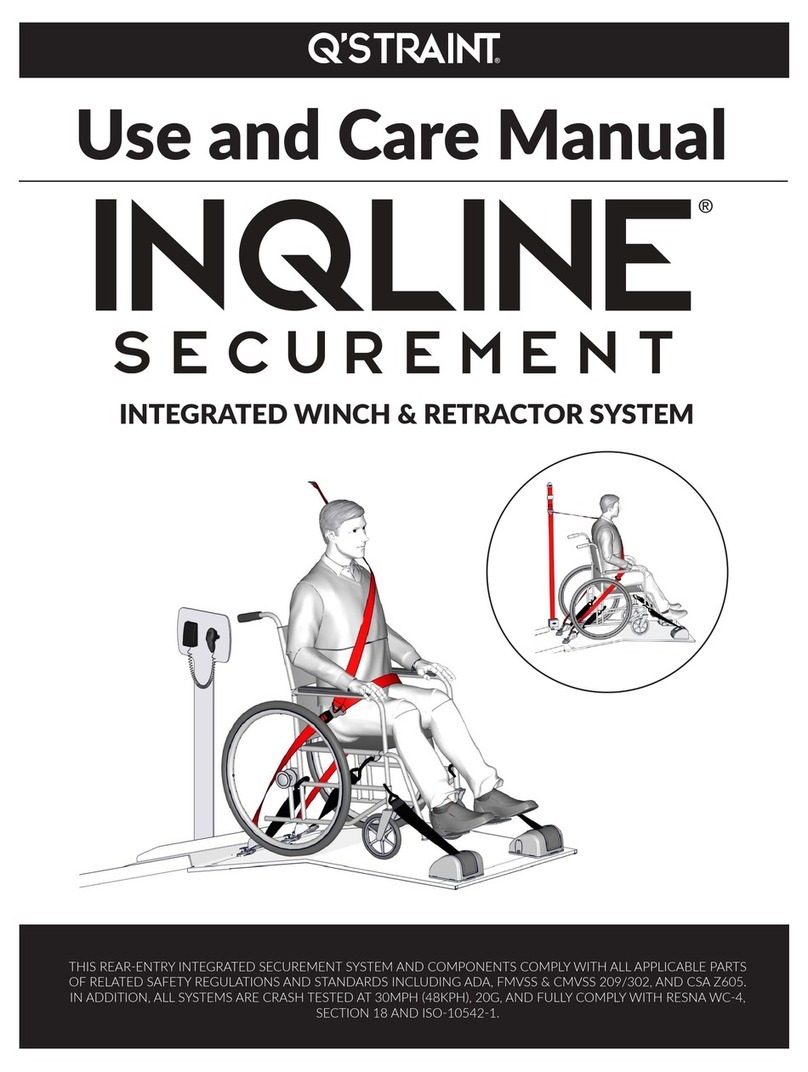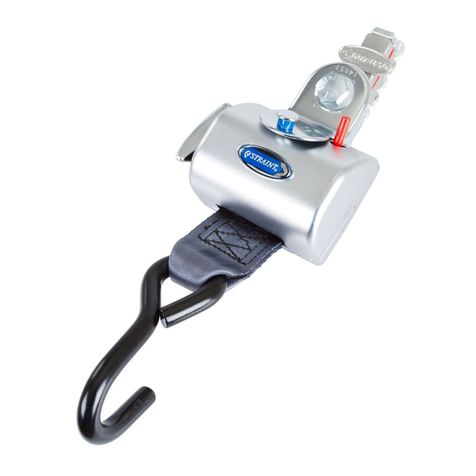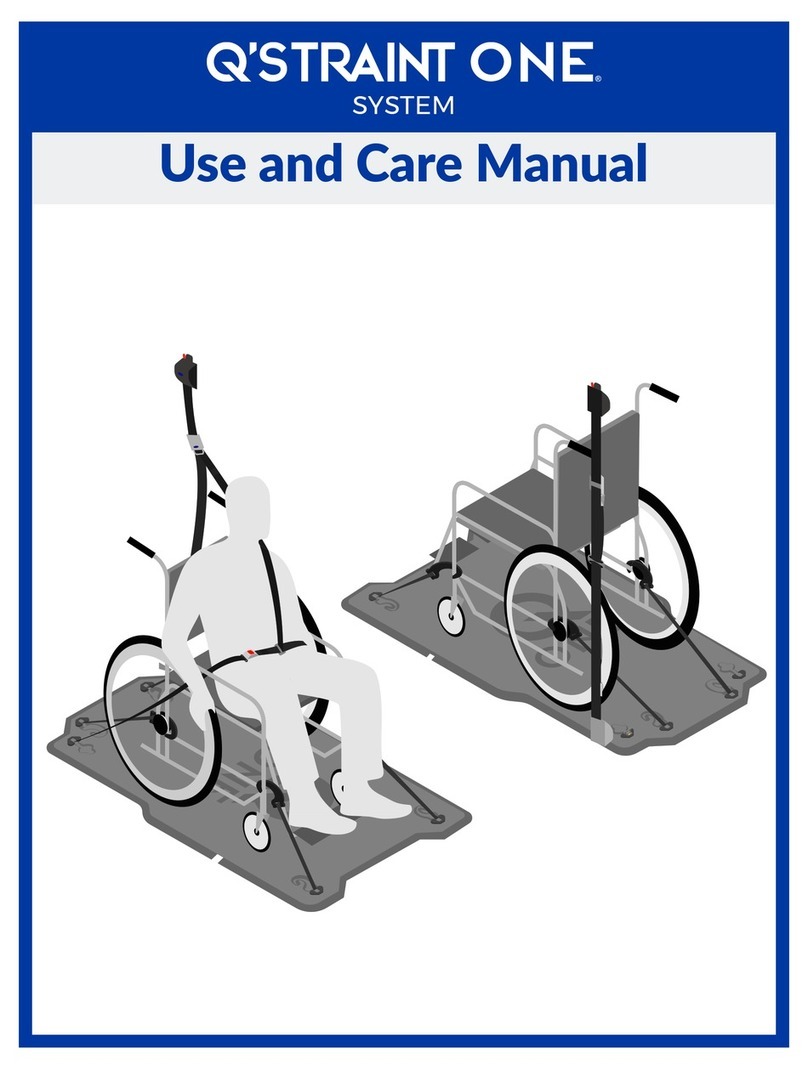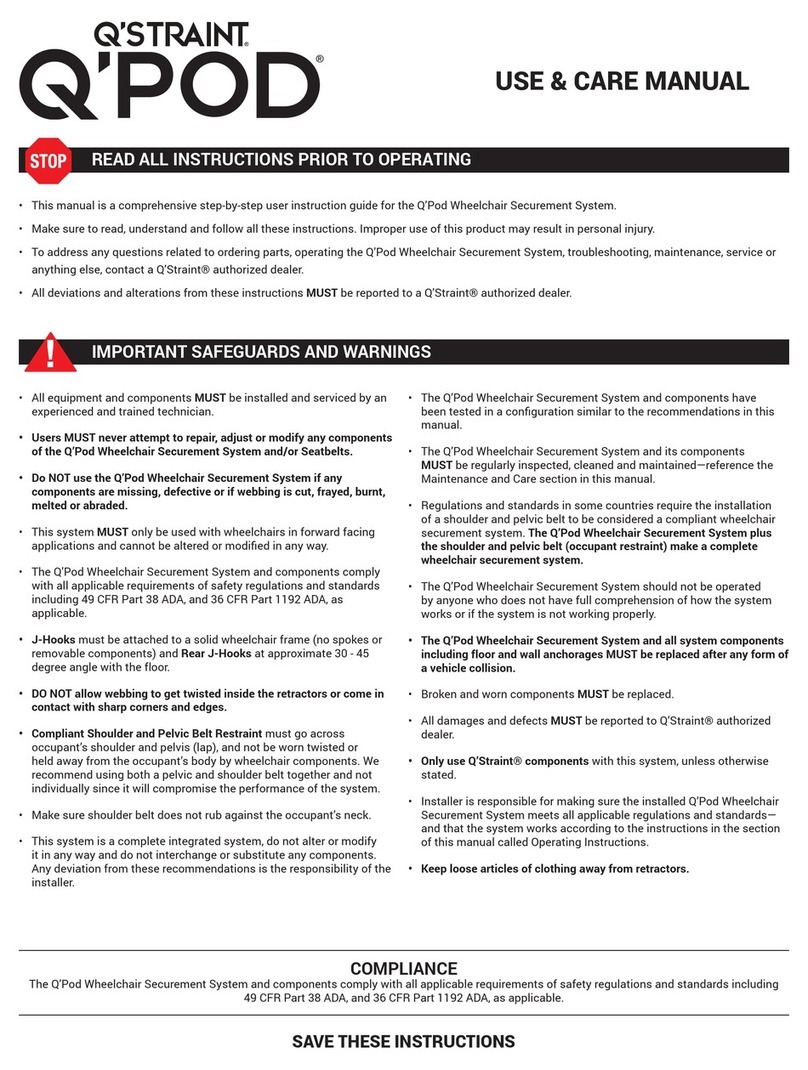
READ ALL INSTRUCTIONS PRIOR TO USE
• This manual is a comprehensive step-by-step guide for the following 4-point Wheelchair Securement Systems: QER -
Q’straint Electrical Front Retractor, QRT-1 Series - QRT Deluxe, QRT Max & QRT Standard, QRT-3 Series - QRT350e, QRT-5
Series - QRT550e, M-Series & Q-5000 Series
• Make sure to read, understand and follow all these instructions.
• To address any questions relating to ordering parts, operating this 4-Point Wheelchair Securement System, troubleshooting,
maintenance, service or anything else, contact a Q’Straint® authorized dealer.
IMPORTANT SAFEGUARDS AND WARNINGS
SAVE THESE INSTRUCTIONS
• All equipment and components MUST be installed and
serviced by an experienced and trained technician.
• Wheelchairs are not intended to be used as seats in motor
vehicles unless compliant with ISO7176-19.
• System are only compliant with ISO10542-1 for
wheelchairs in forward facing applications.
• The Q’Straint® 4-Point Wheelchair Securement System
MUST only be used with one wheelchair and one occupant
at a time
• The Q’Straint® 4-Point Wheelchair Securement Systems
are complete integrated systems, do not alter or modify
them in any way and do not interchange or substitute any
components. Any deviation from these recommendations
is the responsibility of the installer.
• Electrical Retractors are designed and tested to ONLY
be used as a front tiedown as part of Q’Straint® 4-Point
Securement System.
• Regulations and standards in some countries require the
installation of a shoulder and pelvic belt to be considered
a compliant wheelchair securement system. The Q’Straint®
4-Point Wheelchair Securement System plus compliant
shoulder and pelvic belt (occupant restraint) make a
complete wheelchair securement system.
• If a head restraint is anchored to the vehicle, a vehicle
anchored back restraint MUST be provided to minimize
rearward deection of the wheelchair seatback and
therefore prevent injury.
• Installer is responsible for making sure the installed 4-Point
Wheelchair Securement System meets all applicable
regulations and standards—and that the system works
according to the instructions in the section of this manual
called Testing the Q’Straint® 4-Point Securement System.
• Tie-Down Hooks must be attached to a solid wheelchair
frame (no spokes, wheels or movable components) at an
approximate 45-degree angle with oor.
• DO NOT allow webbing to get twisted inside the retractors
or come in contact with sharp corners and edges.
• Compliant Shoulder and Pelvic Belt Restraint must
go across occupant’s shoulder and pelvis (lap), and not
be worn twisted or held away from the occupant’s body
by wheelchair components. We recommend using both
a pelvic and shoulder belt together and not individually
since it will compromise the performance of the system.
• The Q’straint®4-Point Wheelchair Securement Systems,
components and anchorages have been tested in a
conguration similar to the recommendations in this
manual.
• This Q’straint® 4-Point Wheelchair Securement System and
its components MUST be regularly inspected, cleaned and
maintained—reference the Maintenance and Care section
in this manual.
• The Q’straint®4-Point Wheelchair Securement Systems
should not be operated by anyone who does not have full
comprehension of how the system works or if the system is
not working properly.
• Make sure shoulder belt does not rub against the
occupant’s neck.
• Postural supports and belts MUST not be relied on for
occupant restraint in motor vehicle.
• Auxiliary wheelchair equipment must be eectively
secured to the wheelchair or removed from the wheelchair
and secured in the vehicle during transport.
• Items attached to the wheelchair in front of the wheelchair
occupant, other than foot supports, (for example, trays),
must be removed wherever possible and secured
separately during transportation, in order to reduce the
potential for injury to the wheelchair occupant and others
in the vehicle.
• These 4-Point Wheelchair Securement Systems and
all system components including oor and wall
anchorages MUST be replaced after a vehicle collision.
• Broken and worn components MUST be replaced.
• All damages and defects MUST be reported to supervisor
and Q’Straint®.
• Airbags should be used only as an added safety device
in conjunction with a wheelchair securement system, a
shoulder and pelvic belt restraint system that are compliant
with the requirements of SAE J2249, ANSI/RESNA WC-4
SECTION 18, ISO 10542-1, UNECE Regulation 16 or CSA
Z605.
• The airbag MUST be disconnected if the wheelchair
occupant is positioned less than 7”(177.8mm) from the
airbag unit, or if an aftermarket device is installed to block
the deployment of the airbag.
• Keep loose articles of clothing away from retractors.
